
Annie and Me at The Succulent Cafe
During succulent celebrity Annie Schreck's week-long visit to Southern CA, we went (of course!) to The Succulent Cafe near San Diego. This patio-garden eatery specializing in pastries, espresso and colorful succulents in decorative containers. Location: 505 Oak Ave., Carlsbad, CA, three blocks from the beach.
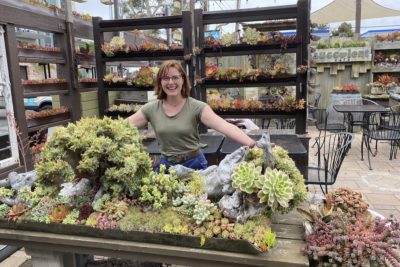
Annie with a driftwood succulent arrangement at The Succulent Cafe
Meet Annie
Annie is the staff horticulturist and researcher who produces informational videos for the largest online succulent nursery: Mountain Crest Gardens.
As she and I sat amid walls of succulents and chatted over lavender mocha and chai, Annie explained she has "the coolest job in the world" despite it being "the middle of nowhere" in northern CA. In the video, Annie mentions some of her favorite succulents, including two she spotted while hiking the Pacific Northwest.
About the Succulent Cafe
I'm pleased to share this description of The Succulent Cafe from an article I did for a Better Homes & Gardens publication two years ago:
"Owner Peter Loyola's aim is 'to create an environment that appeals to all the senses.' He achieves this with fragrant coffee, flaky pastries, a splashing fountain, soft music, and colorful plants in textural containers.

Succulents in soup ladles at The Succulent Cafe
"Loyola enjoys the challenge of planting succulents in objects such as wood pallets, vinyl gutters, and vintage kitchen utensils. 'The more patina the better,' he says, gesturing to a verdigris copper colander holding blue and pink echeverias.
"In addition to coffee drinkers, dogs on leashes, babies in carriages, and brightly dressed cyclists, visitors include tourists taking photos. 'Locals come here to unwind,' Loyola says. 'But if you're from Minnesota, you probably don't see succulents all that often, and you're mesmerized.'
"When designing with succulents, Loyola often places the largest plant in the center, then surrounds it with smaller ones. Containers may also have a cascader, like a fine-leaved sedum, string-of-pearls (Senecio rowleyanus) or burro tail (Sedum morganianum)."
See 40+ examples in the Gallery below.
More Annie Adventures
This video---part of a series of Annie's succulent adventures in my neck of the woods---introduces you to the effervescent, engaging Annie. In a different video, she introduces yours truly to her fans and followers.
Soon to come in the series are additional destinations as well as fun, creative projects. Make sure you don't miss any by subscribing to my YouTube channel and that of Mountain Crest Gardens.
Annie and I both welcome your comments and questions!















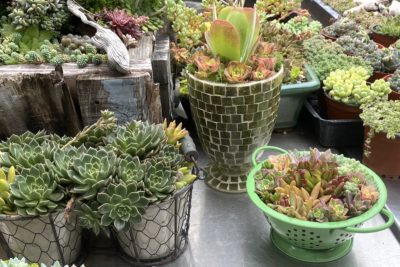
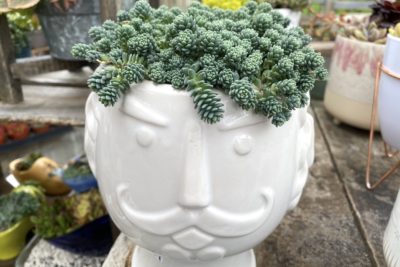
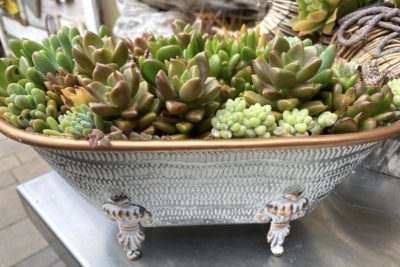
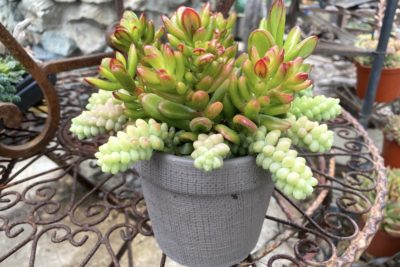
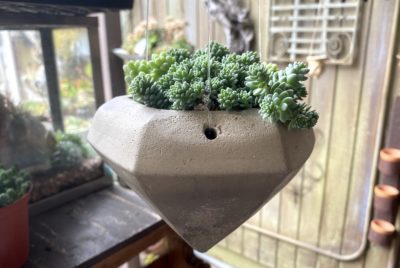


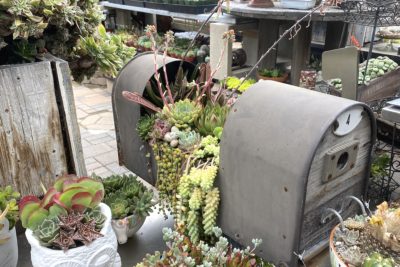

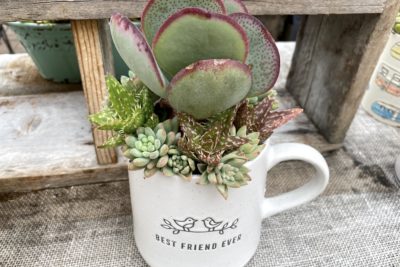





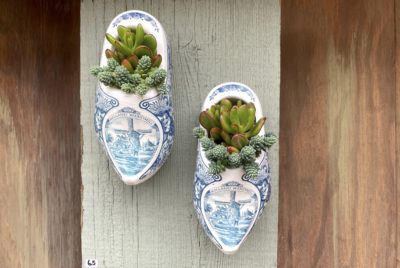

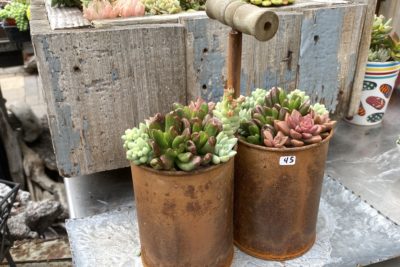





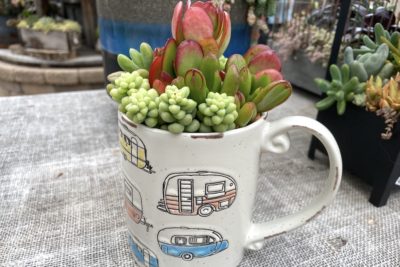
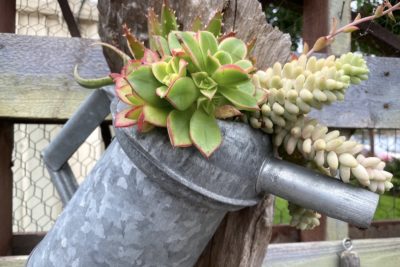


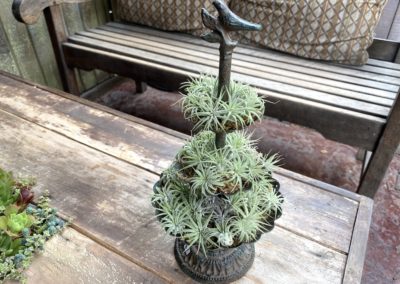
Inspirational, as usual!
Purr. Thank you!!
Isn’t it dangerous to
Plant in a copper container?
Otherwise, thanks for the interesting video and the inspiring photos. Your weekly video is something I wait for regularly.
Isn’t it unhealthy to plant in a copper container?
Good point. I can’t speak from experience, but based on Googling “planting in copper containers” it’s probably better to use a copper vessel as a cache pot (set another pot inside it). Thanks for the head’s up!
Hi Debra,
I have been a fan of you , and really enjoy watching your educational Youtube video.
I started growing succulents last spring, and can now grow them with some confidence. Unfortunately I have many etiolated plants, despite the fact that they are grown in very bright or under direct (morning) sun light for at least a couple of hours a day. I am not sure if feeding them with cactus and succulent liquid plant food (diluted at 1/4 – 1/2 of the recommended dosage) every time I water them caused the plant to etiolate .
Any suggestion would be much appreciated.
Thank you !
Hi Kim — Etiolation is when plants stretch in search of sun. Their leaves will droop and they’ll lean, and stems become spindly. Fertilizer may encourage more growth, but basically it’s a light problem. Learn more on my page, “How Much Light Do Succulents Need?”
Hi Debra, I have followed you for years and love all you do. I have one concern though. I live in Phoenix AZ where the night temps in summer often do not drop below 85-90º. The “soft succulents are a big problem here due to CAM. I belong to a number of Facebook pages on gardening in the desert and so, so many people question what is happening to their succulent plants here. Of course, often they believe they have done something wrong when they haven’t and they get discouraged trying to grow these plants. I really feel you should mention that those in hot night desert areas need to bring the soft succulents inside in summer or grow more cactus type plants that can take the night heat or use the soft succulents as “annuals” or maybe you have other suggestions. I hate to see people turned off plants due to this problem!
Thank you.
Thanks for the suggestion, Nancy. Very timely as I’ll be addressing a group of desert gardeners soon! Debra
Hi Debra–I found your website today as I searched for answers about my ice plant die off. We live on a hillside in Camarillo with very sandy, well drained soil. All we can grow here are natives, succulents and lantana. We had a nice ring of ice plant surrounding the house that has died off this year and is 75% dead now. It’s been irrigated three times a week and did fine up until a year ago when the die off began. Not sure if I should re-plant with ice plant cuttings in small sections slowly or plant something entirely different. I hear the ice plant is bad for hillsides (potentially causing a landslide due to weight) but I feel like it’s the best thing for fire protection. The hillsides are very steep so will need something low maintenance.
Hi Alice — “Ice plant” can be any of a number of trailing succulent plants. But what happened to yours sounds like the fungus that has caused massive die-off of red apple (Aptenia cordifolia). Ice plants that root as they grow (from their stems) actually help stabilize hillsides, as opposed to those that have a single taproot. Learn more on this site’s Ice Plant page. https://debraleebaldwin.com/ice-plant-uses-photos-ids/
We had a die off of carpobrotus ice plant not the red apple. It may be good fortune that it mostly died off since you mention that it destabilizes hillsides and ours is on a steep hill. Also, what is left behind is the dead plants which as you mention pose a fire danger. I think I’ll try and replace it in small sections over time with one of the Lampranthus varieties. Thanks for your help!
Sounds good, Alice! Glad I could help.